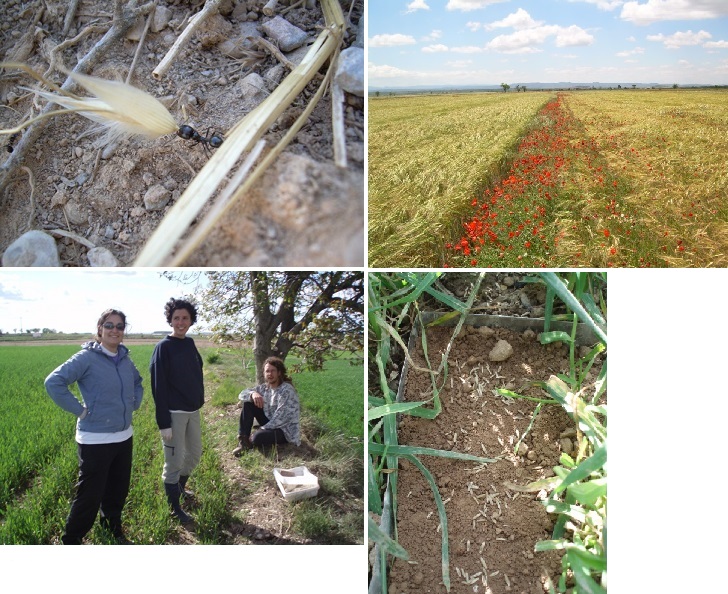Seed predators and weed seed predation for weed control in winter cereals
Seed predation can cause significant losses of weed seeds in agricultural systems and can, thus, contribute to weed control. Knowledge on the identity and relative contribution to weed control by various seed predators, and on factors limiting seed predation is currently lacking. This study aimed at casting light on these aspects for the specific case of winter cereal fields in semi-arid north-eastern Spain. This area is traditionally managed without irrigation and with tillage. However, an ever increasing proportion of the arable land is being irrigated and the remainder of the rain fed land is managed without tillage. The impact of tillage and irrigation on weed seed predators and seed removal rates were, therefore, studied.
The study showed that in the rain-fed area, Messor barbarus harvester ants are contributing substantially to weed control by removing large quantities of weed seeds during spring and summer. Tillage during summer decreased predation rates and buried most of the weed seeds located on the soil surface, thus preventing further seed removal. Tillage also decreased the number of harvester ant nests compared to no-till fields. The expansion of the area that is managed with minimum and no-till should result in high natural weed control level over a large area. In contrast, inundative irrigation completely eliminated harvester ants, and led to the almost complete loss of this ecosystem service. Although carabid beetles and rodents were present in the field edges, predation rates in the field interior were extremely low. Causes for the lack of seed predation are still unknown and should be further investigated.
Densities of harvester ant nests varied enormously between rain fed fields; concomitant weed seed predation rates are expected to vary accordingly. Causes for this variability could not be identified. Harvester ant nest density did not correlate with the most common soil characteristics, topographic variables or crop and management practices, with the exception of the number of years of no-till. Harvester ant density was highest after 11-12 years of no-till. Other than that, no recommendations could be formulated to increase nest densities in those areas where they are low.
Success of weed seed predation as an ecosystem service also depends on the ability of predators to respond in a direct density dependent way to increasing seed densities. The density dependent response of granivorous rodents to seed patches with varying density was investigated in winter cereal fields of north-eastern Germany. Rodents responded in a direct density dependent way to increasing seed densities and are, therefore, expected to effectively control weed patches. The density dependent response by harvester ants and granivorous rodents in cereal fields in NE Spain are currently being investigated.
It is feasible that harvester ants occasionally destroy crop seeds and cause crop damage. Yield loss caused by M. barbarus was, however, negligible (0.4 % of yield), and was explained by nest density, nest size and number of years without tillage. Based on these results, damage caused by harvester ants was more than offset by the benefits with regard to weed control. However, occasional higher yield losses (max. 9.2%) were recorded and the conditions leading to higher losses should be investigated further.
This study exemplifies both the strength and vulnerability of an ecosystem service. High weed seed predation by harvester ants is occurring naturally in rain-fed cereals in north-eastern Spain and contributes substantially to weed control. However, this service can easily be lost as illustrated by the absence of seed predation in the flood irrigated areas and the response of harvester ants to excessive tillage. Existing densities of harvester ant nests could be preserved by limiting the level of soil disturbance. In semi-arid regions, cereal production is marginally cost effective due to limited water availability and, therefore, preserving natural weed control by harvester ants is needed in order to preserve the sustainability of the system.
Publications
Daedlow D, Westerman P R, Baraibar B, Rouphael S, Gerowitt B (2014) Weed seed predation rate in cereals as a function of seed density and patch size, under high predation pressure by rodents. Weed Research 54(2), 186-195.
Baraibar B, Daedlow D, de Mol F, Gerowitt B (2012) Density dependence of weed seed predation by invertebrates and vertebrates in winter wheat. Weed Research 52(1), 79-87.
Baraibar B, Carrión E, Recasens J, Westerman PR (2011) Unravelling the process of weed seed predation; seed cache finding, seed utilization and seed preference. Biological Control 56, 85-90.
Baraibar B, Ledesma R, Royo-Esnal A, Westerman PR (2011) Assessing yield losses caused by granivorous ants, Messor barbarus L., in winter cereals. Crop Protection 30, 1144-1148.
Baraibar B, Torra J, Westerman PR (2011) Harvester ant (Messor barbarus (L.)) density as related to soil properties, topography and management in semi-arid cereals. Applied Soil Ecology 51, 60-65.
Daedlow D, Baraibar B, de Mol F, Gerowitt B (2011) Density dependence of weed seed predation by invertebrates and vertebrates in wheat. Proceedings 4th Workshop of EWRS Working Group Weeds and Biodiversity, 43.
Baraibar B, Torra J, Westerman PR (2010) Soil characteristics influence granivorous ant populations in dryland cereals. Proceedings 15th Symposium of the European Weed Research Society, Kaposvár, Hungary, 172.
Westerman PR, Baraibar B, Deadlow D, Liebman M (2010) Managing weed seed predation in arable fields. IOBC/WPRS Bulletin 56, 143-146.
Baraibar B, Westerman PR, Carrión E, Recasens J (2009) Effects of irrigation and tillage in cereal fields on weed seed removal by predators. Journal of Applied Ecology 46, 380-387.
Baraibar B, Westerman PR, Carrión E, Recasens J (2009) Effects of tillage and irrigation in cereal fields on weed seed removal by seed predators. Proceedings 3rd Workshop of EWRS Working Group Weeds and Biodiversity, 49.
Daedlow D, Baraibar B, Westerman PR, de Mol F (2009) Comparing methods to measure the effect of weed seed densities on seed predation rates in cereals. Proceedings 3rd Workshop of EWRS Working Group Weeds and Biodiversity, 56.

